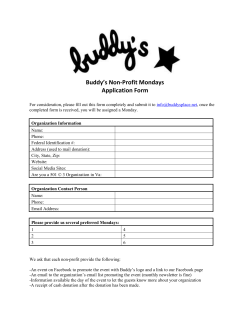
CW4 Synesthesia
ALISSA BOHLING READ-ALOUD, DISCUSSION, AND JOURNAL EXERCISE ON SYNESTHESIA Use this classroom resource to lead a read-aloud, discussion, and journal exercise with your students about the literary technique synesthesia. Synesthesia is the description of a sensory experience of touch, taste, smell, sound, or sight from the perspective of one of the other senses. PART 1: Read-aloud Use the following excerpts to introduce your class to these synesthete characters: Alison from R.J. Anderson’s book Ultraviolet, Luke from Nicola Morgan’s book Mondays Are Red, Noel from Jeffrey Moore’s book The Memory Artists, and Mia from Wendy Mass’s book A Mango-Shaped Space. Use the questions that follow the excerpts for discussion after the read-aloud. Then invite your students to journal on one of the prompts provided at the end of this guide. Alison from Ultraviolet by R.J. Anderson: "That day I'd learned that my mind didn't work the same as other people's--that perceptions I took for granted could seem incredible or even frightening to them. So I couldn't talk about the color of three, or whether triangles tasted better than circles, or how playing Bach on my keyboard made fireworks go off in my head, because people would think I was crazy. And then they'd be scared of me, and wouldn't want to be around me anymore." [1] Luke from Mondays Are Red by Nicola Morgan: “Mondays are red. Sadness has an empty blue smell. And music can taste of anything from banana puree to bat’s pee. That’s what I need to explain, starting from the day it all began, the day I woke up in a hospital bed with a kaleidoscope in my head. I discovered later that I had almost died from meningitis but I remember nothing about that bit. My first memory is the dizzy waking up part and my soggy muddled head. My second memory is how, bit by bit, I began to realize how much my world had changed. . . . Mondays had never been red before. Mondays had had no color at all before. Mondays were simply days that followed Sundays and meant no P.E. at school. But now when I thought of Monday, I saw red velvet, felt its warmth, tasted the corners of its softness. And I knew that violin music would not have sounded like lemons or made me cry the day before I fell ill.” [2] Noel from The Memory Artists by Jeffrey Moore: “Most people want to learn how to remember more; for Noel Burun, the big task, the most burdensome, was to learn how to forget. Not only the painful things in life, which we all want wiped away, but things in general. For whenever Noel heard a voice or read a word, multicoloured shapes would form ALISSA BOHLING inside his head that served as markers or maps, helping him to recollect, in minutest detail, an emotion, a mood, a tone of voice, the words themselves--of events that happened up to three decades ago. . . . ‘Congratulations,’ said the doctor with unaccountable good cheer, in French, after a mind-deadening battery of perception and memory tests. ‘You’re one in twenty thousand. You’re blessed -- although sometimes you may feel cursed--with a complex sensitivity known as synaesthesia.’ Why is he so happy? Noel wondered as the doctor shook his little hand. Because he can experiment on me like one of his chimpanzees? ‘You’re the first male synaesthete I’ve met. Now, I want you to do something that will help us both a great deal. I want you to keep a diary. Do you know what a diary is?’ ‘Yes, I already keep one.’ ‘A diary is a book in which you write down things that happened to you during the day. Or events of your past. Or in your dreams--’ ‘Once I dreamt I was walking through this giant crossword puzzle.’ ‘Or the colours and shapes you see in your head when people talk to you. And I’d like to see it at the end of every month. Do you understand?’ ‘Sometimes when people talk I wish I had a decoder ring.’” [3] Mia from A Mango-Shaped Space by Wendy Mass: “Mrs. Lowe put her hands on her hips. ‘I’ve had enough of this. For the last time, numbers do not have colors. Now, are you going to complete the assignment?’ I stared at her and shook my head. I suddenly felt very small, as if my skin was tightening and I was actually shrinking. A whirring sound filled my head. How was this possible? Was everyone playing a trick on me? Of course numbers had colors. Were they also going to tell me that letters and sounds didn’t have colors? That the letter a wasn’t yellow like a faded sunflower and screeching chalk didn’t make red jagged lines in the air? I replaced the chalk on the ledge, aware for the first time that my hands shake when I’m nervous. I stood with my arms at my sides, sleeves hanging halfway to my knees. Was I the only one who lived in a world full of color? I waited to see if they were going to tell me the earth was flat.” More from Mia from A Mango-Shaped Space by Wendy Mass: “The wind starts up slightly and a big green leaf sticks to the sweat on my leg. I hold still and count to twelve before it flutters and falls to the ground. The color of the leaf is exactly the same color as Jenna’s name--a bright, shimmering shade of green with some yellow highlights. I think part of why I liked Jenna right away is that I like the color of her name. But I’d never tell her that, nor would I tell my older sister, Beth, that her name is the murky brown of swamp water. Beth is sixteen and in the process of wearing down our parents’ patience. She changes her hair color the way normal people change their underwear. We used to be a lot closer until she went to high school and dropped me like a piping-hot bag of microwave popcorn. Before she left for the summer, she told me the boys would pay more attention to me if I colored my hair blond. I told her I’d stick with my boring brown, thank you very much. The only natural blonde in the family is Zack. He just turned eleven, and his name is the ALISSA BOHLING light blue of a robin’s egg. Zack has a lot of strange ideas. He can tell you how many McDonald’s hamburgers he’s eaten in his lifetime. He has a detailed chart on his wall.”[4] 1. Anderson, R.J., Ultraviolet, Minneapolis: Carolrhodabooks, 2011. 2. Morgan, Nicola, Mondays Are Red, Crabbit Publishing, 2002. 3. Moore, Jeffrey, The Memory Artists, New York: St. Martin’s Griffin, 2004. 4. Mass, Wendy, A Mango-Shaped Space, New York: Hachette Book Group, 2003. PART 2: Discussion Questions These characters are describing things they can see, touch, taste, smell, and feel. Did you see, touch, taste, smell, or feel anything while you were listening? What was it? These characters feel, smell, taste, hear, and see things in a way that is different from other people. Sometimes it gets them into trouble or makes them feel left out. Have you ever gotten into trouble or felt left out because you felt different from other people, or because they thought you were different? If so, do you think that would be interesting to write about? Why or why not? When we write, we use our minds a lot: to concentrate, to imagine, to plan our stories, to spell words and write sentences. What about our bodies--can they help us write the way our minds do? How? When we read, look at artwork like paintings and drawings, and watch dance performances, we use our eyes. When we listen to music, we use our ears. What about the rest of our bodies? Do we use them while we’re learning about art? Why or why not? If not, should we try it? Why or why not? PART 3: Journal Exercise Students can choose one prompt or write on both if they have time: 1: "A time I felt different from those around me was ... " Use at least three of the five senses to describe your experience. Use at least one synesthesia. If you don't want to write about yourself, write about a fictional character from your imagination. 2: Some people believe human beings have a sixth sense, a way of knowing something that can't be known with our other five senses. Write about whether you agree, disagree, or partially agree, and why. 3. Sometimes we find solutions to difficult problems when we change our point of view to one that is new, different, or even strange, like the characters you met in the read-aloud. Write about a problem you have had at school that was solved--or could have been solved--when you or someone you know looked at the problem in a new way.
© Copyright 2025










